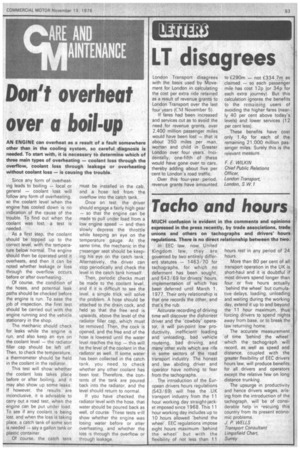"MAINTENANCE Don't overheat over a boil-up
Page 55

If you've noticed an error in this article please click here to report it so we can fix it.
AN ENGINE can overheat as a result of a fault somewhere other than in the cooling system, so careful diagnosis is needed. To start with, it is necessary to determine which of three main types of overheating — coolant loss through the overflow, coolant loss through leakage or overheating without coolant loss — is causing the trouble.
Since any form of overheating leads to boiling — local or general — coolant loss will follow any form of overheating, so the coolant level when the engine has cooled down is no indication of the cause of the trouble. To find out when the coolant was lost, a test is needed.
As a first step, the coolant should be topped up to the correct level, with the temperature below normal. The engine should then be operated until it overheats, and then it can be noted whether leakage or loss through the overflow occurs before or after overheating.
Of course, the condition of the hoses, and potential leak paths should be checked before the engine is run. To ease the job of inspection, the first test should be carried out with the engine running and the vehicle stationary in the shop.
The mechanic should check for leaks while the engine is run, and also keep an eye on the coolant level — the radiator filler cap should be left off. Then, to check the temperature, a thermometer should be held in the coolant in the radiator.
This test will show whether the coolant loss takes place before or after boiling, and it may also show up some leaks. If however, the results are inconclusive, it is advisable to carry out a road test, when the engine can be put under load. To see if any coolant is being lost, and when the loss is taking place, a catch tank of some sort is needed say a gallon tank or plastic container.
Of course, the catch tank must be installed in the cab, and a hose led from the overflow into the catch tank.
Once on test, the driver should engage a fairly high gear -so that the engine can be made to pull under load from a low, engine speed — and then slowly depress the throttle while keeping an eye on the temperature gauge. At the same time, the mechanic in the rassenger seat should be keeping his eye on the catch tank. Alternatively, the driver can stop periodically and check the level in the catch tank himself.
Then, periodic checks must be made to the coolant level, and if it is difficult to see the level; a simple trick will solve the problem. A hose should be attached to the drain cock, and held so that the free end is upwards, above the level of the radiator filler cap, which must be removed. Then, the cock is opened, and the free end of the hose is lowered until the water level reaches the top — this will be the level of the coolant in the radiator as well. If some water has been collected in the catch tank, you need to check whether any other coolant has been lost. Therefore, the contents of the tank are poured back into the radiator, and the level should return to normal.
If you have checked the radiator level with the hose, that water should be poured back as well, of course. These tests will show whether the engine was losing water before or atter overheating, and whether the loss :s through the overflow or through leakage.




































































































